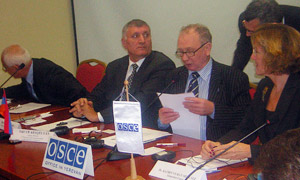The first steps are being taken: there is a plan and the main goal is to make the transition from analogous (currently used) broadcasts to digital broadcasts. According to the deputy minister, Armenia will need 50-60 million dollars for the implementation of that project and a part of the money will be provided by the state.
General Director of the television and radio networks of Armenia Ashot Simonyan mentioned that since Armenia has started the process late (the International Broadcasting Union has given the list of digital frequencies to Armenia this year), there has been a try to come up with the model for the transition from analogous to digital broadcast. In other words, they have drawn their attention to legislative, technical and other issues. They have taken into consideration Armenia’s conditions, the small and packed territory, the mountainous regions and the fact that Armenia doesn’t have its own satellite system.
The current network of Armenia’s broadcast includes the public broadcaster and 50 private broadcasters. As for coverage, Armenia’s public television places first with 99.8% and the second is the Armenian Second Channel with more than 93%. The Russian RTH and OTH channels also have a large coverage.
Mr. Simonyan mentioned that cable broadcast is not developed in Armenia-it only makes up 1.3% and the satellite is .5%. However, A. Simonyan believes that Armenia’s broadcasting network is in very good condition and can’t be compared with the networks of CIS countries. The higher-ground substructures can be used to make the transition to digital broadcast.
The director of the network also said that there is no such document approved in any of the CIS countries. Only four years ago did Russia plan the system out, but it hasn’t been confirmed.
It was also mentioned that in the case of digital television, TV viewers must have either new, digital TVs, or the corresponding attaches. In fact, it’s foreseen to produce them in Armenia. Armenians will bid farewell to analogous television when 85-90% of people have the necessary equipment. The program has been presented to the experts and expert Dr. Katherine Nayman Metcalf presented her views during a discussion. She mentioned that she was rather impressed by the program. However, there were some issues worth paying attention to . According to Mrs. Metcalf, it’s necessary to study the experience of European countries, but in this field, there isn’t even one politics for this in European countries.
Digital television is going to represent a couple of package deals of which one must be free of charge and accessible to all levels of society. According to the expert, the public broadcast must definitely be included in the package. The other package deals will be charged. “People must be able to move from one package to another easily without getting new equipment”.
The preliminary investment expenses for digitalization are rather large. From this aspect, Metcalf considers it possible to see some funding from the state. But there has beo be balance so that some companies don’t get the preference. “If you’re not careful, then you can have new TV channels coming into the light, but there won’t be varied opinions,” mentioned K. Metcalf.
The investments necessary for digitalization, besides being large, also require a lot of time to bring them back. That’s why the investor must be secured. In order to help the flow o f investments, according to Mrs. Metcalf, it’s necessary for the state to help. Large expenses are dangerous because they can create a monopoly in this field and not everyone can afford paying that much for digital television.
International Relations expert Richard Kirakosyan was also present during the discussion and expressed his views and just amazed the journalists. However, Mr. Kirakosyan clarified that he had been involved with digital communication during his years in the U.S. Congress.
Perhaps the most interesting speech was made by director of the Informational Right and Politics Center David Sandukhchyan. Mr. Sandukhchyan started his observations from the title of the program. “I would call this program “Armenia’s broadcasting network” company rearmament program because it doesn’t really focus on private companies. The program deals more with the rearmament of the network and the digitalization of communication.”
D. Sandukhchyan didn’t accept the fact that the package deal of the program is going to be confirmed by the government because “the government, being a political body, can’t be subjective”. According to Sandukhchyan, the three package deals predict, in the best case scenario, 18 channels, which is less than the current number of TV channels in Armenia. So, the TV companies not included in the program are in a difficult situation. “Armenia, in contrast to European countries, doesn’t have a cable network in order to have the companies not included in the list to broadcast their programs via the cable network,” said Sandukhchyan. He also didn’t agree with stopping analogous broadcast after 85-90% of people get the digital attaches. “The attaches can’t be a standard,” said Mr. Sandukhchyan.
The latter also touched upon other issues expecting to hear an opinion from one of the representatives of the Ministry of Transportation and Communication. He did get some feedback. After the break, deputy minister of transportation and communication V. Arakelyan had left and it was all up to Ashot Simonyan and the latter wasn’t too happy. “I don’t know why I have to answer the questions for a group of ministry officials,” said Simonyan, saying that it would have been better if D. Sandukhchyan presented concrete suggestions instead of giving questions.

